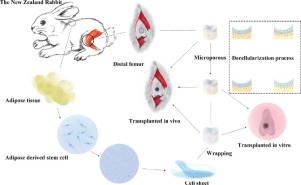当前位置:
X-MOL 学术
›
Cytotherapy
›
论文详情
Our official English website, www.x-mol.net, welcomes your
feedback! (Note: you will need to create a separate account there.)
Microporous acellular extracellular matrix combined with adipose-derived stem cell sheets as a promising tissue patch promoting articular cartilage regeneration and interface integration
Cytotherapy ( IF 3.7 ) Pub Date : 2019-08-01 , DOI: 10.1016/j.jcyt.2019.02.005
Yuxiang Zhang 1 , Gang Feng 1 , Guoping Xu 1 , Yiying Qi 1
Cytotherapy ( IF 3.7 ) Pub Date : 2019-08-01 , DOI: 10.1016/j.jcyt.2019.02.005
Yuxiang Zhang 1 , Gang Feng 1 , Guoping Xu 1 , Yiying Qi 1
Affiliation

|
BACKGROUND
Acute or chronic injury of articular cartilage leads to localized destruction. Difficulties with interface integration between the implant and native cartilage tissue can lead to an undesirable outcome. To improve cartilage repair and interface integration, we explored the therapeutic efficacy of microporous acellular extracellular matrix (ECM) combined with adipose-derived stem cell (ASC) sheets. METHODS
Methods for fabricating ASC sheets and microporous acellular ECM were explored before transplanting the constructed ASC sheet/matrix in vivo and in vitro, respectively. After the operation, distal femur samples were collected at 6 and 12 weeks for further analysis. RESULTS
The decellularization process removed 90% of the DNA but retained 82.4% of glycosaminoglycans (GAGs) and 82.8% of collagen, which are the primary components of cartilage matrix. The acellular matrix/ASC sheet construct treatment in vivo showed better interface integration, cartilage regeneration, and collagenous fiber arrangement, which resembles the native structure. There was a significant increase in GAG and collagen accumulation at the zone of regeneration and integration compared to other groups. Gene expression analysis showed that the mRNA level associated with cartilage formation significantly increased in the acellular matrix/ASC sheet group (p<0.05), which is consistent with the histological analysis. DISCUSSION
ASC sheets promote interface integration between the implant and native tissue. This effect, together with the acellular matrix as a graft, is beneficial for cartilage defect repair, which suggests that acellular matrix/ASC sheet bioengineered cartilage implants may be a better approach for cartilage repair due to their enhanced integration.
中文翻译:

微孔脱细胞细胞外基质结合脂肪干细胞片作为一种有前景的组织补片促进关节软骨再生和界面整合
背景关节软骨的急性或慢性损伤导致局部破坏。植入物和天然软骨组织之间的界面整合困难会导致不良结果。为了改善软骨修复和界面整合,我们探索了微孔脱细胞细胞外基质 (ECM) 与脂肪干细胞 (ASC) 片相结合的治疗效果。方法在分别将构建的 ASC 片/基质移植到体内和体外之前,探索了制造 ASC 片和微孔无细胞 ECM 的方法。手术后,在第 6 周和第 12 周收集股骨远端样本进行进一步分析。结果 脱细胞过程去除了 90% 的 DNA,但保留了 82.4% 的糖胺聚糖 (GAG) 和 82.8% 的胶原蛋白,它们是软骨基质的主要成分。体内脱细胞基质/ASC 片结构处理显示出更好的界面整合、软骨再生和胶原纤维排列,类似于天然结构。与其他组相比,再生和整合区的 GAG 和胶原蛋白积累显着增加。基因表达分析显示脱细胞基质/ASC片组与软骨形成相关的mRNA水平显着升高(p<0.05),与组织学分析一致。讨论 ASC 片促进植入物和天然组织之间的界面整合。这种作用与作为移植物的脱细胞基质一起,有利于软骨缺损修复,
更新日期:2019-08-01
中文翻译:

微孔脱细胞细胞外基质结合脂肪干细胞片作为一种有前景的组织补片促进关节软骨再生和界面整合
背景关节软骨的急性或慢性损伤导致局部破坏。植入物和天然软骨组织之间的界面整合困难会导致不良结果。为了改善软骨修复和界面整合,我们探索了微孔脱细胞细胞外基质 (ECM) 与脂肪干细胞 (ASC) 片相结合的治疗效果。方法在分别将构建的 ASC 片/基质移植到体内和体外之前,探索了制造 ASC 片和微孔无细胞 ECM 的方法。手术后,在第 6 周和第 12 周收集股骨远端样本进行进一步分析。结果 脱细胞过程去除了 90% 的 DNA,但保留了 82.4% 的糖胺聚糖 (GAG) 和 82.8% 的胶原蛋白,它们是软骨基质的主要成分。体内脱细胞基质/ASC 片结构处理显示出更好的界面整合、软骨再生和胶原纤维排列,类似于天然结构。与其他组相比,再生和整合区的 GAG 和胶原蛋白积累显着增加。基因表达分析显示脱细胞基质/ASC片组与软骨形成相关的mRNA水平显着升高(p<0.05),与组织学分析一致。讨论 ASC 片促进植入物和天然组织之间的界面整合。这种作用与作为移植物的脱细胞基质一起,有利于软骨缺损修复,































 京公网安备 11010802027423号
京公网安备 11010802027423号